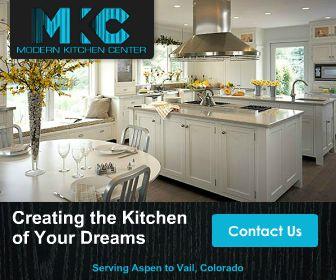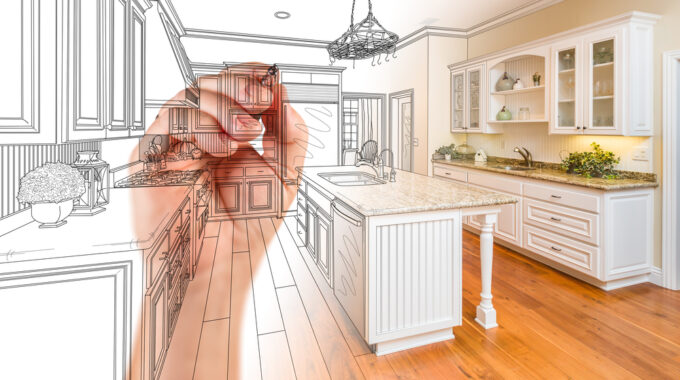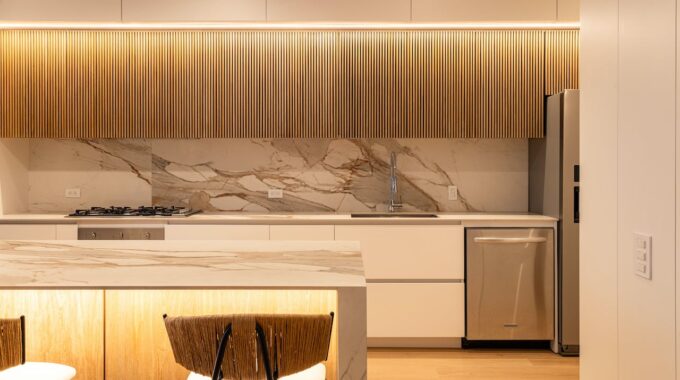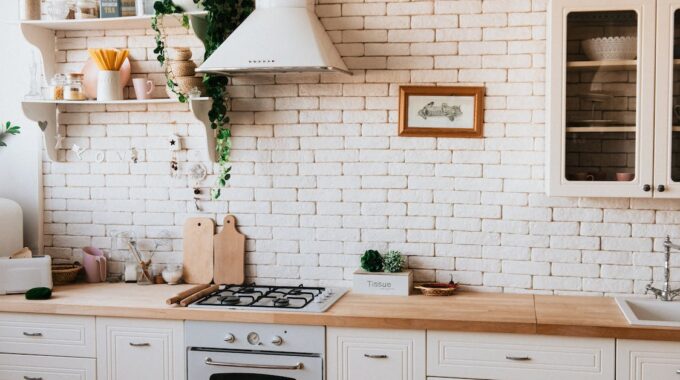
Top 5 Mistakes to Avoid During Kitchen Remodeling
Embarking on a kitchen remodeling project is like preparing a culinary masterpiece. It’s a blend of excitement, creativity, and the anticipation of transforming your cooking space into a haven that suits your tastes and needs. However, just as a dash of too much salt can ruin a dish, certain mistakes can spoil the recipe for a successful kitchen remodel.
Let’s explore the ingredients that go into a disastrous kitchen remodeling recipe. From lack of planning to improper ventilation, we’ll cover it all, helping you avoid the common missteps that can leave you scrambling for a takeout menu instead of confidently serving up a five-star meal in your brand-new kitchen. So roll up your sleeves, grab your favorite strainer, and let’s prepare to sift out the mistakes that can spoil your kitchen remodeling journey.
Lack of Proper Planning
Proper planning is the foundation for a successful and stress-free project. It sets the stage for a well-executed transformation that aligns with your vision and budget. Unfortunately, neglecting the planning phase is a common mistake that can lead to costly delays, unexpected expenses, and unsatisfactory results. Here are a few areas you need to look into for your planning.
Clear Vision: Cook up Your Dream Kitchen
Picture your dream kitchen. What colors, styles, and features make your heart skip a beat? It’s important to establish a clear vision for your project. Take the time to think about what you want to achieve in terms of aesthetics, functionality, and layout. It’s like choosing the perfect recipe for your culinary masterpiece!
Budget: Spice it up with Financial Planning
Nobody wants to bite off more than they can chew, especially regarding finances. Creating a detailed budget is essential to avoid overspending and ensure you stay on track. Consider the cost of materials, labor, permits, and any unexpected expenses. By crunching the numbers ahead of time, you can savor the satisfaction of knowing you’re well-prepared for the financial side of your kitchen remodel.
Measurements and Assessments: Get the Right Ingredients in Place
Imagine baking a cake without knowing the measurements or having the right-sized pans. The same goes for your kitchen remodel. Take accurate measurements of your kitchen space, including walls, windows, doors, and ceiling height. Assess any structural limitations or obstacles that may affect your plans. This way, you can be confident that everything fits together like a perfectly assembled puzzle.
Realistic Timeline: Avoid Rush Hour in the Kitchen
A kitchen remodel is not a microwave dinner. It takes time, and it’s important to set realistic expectations. Establish a timeline that considers the scope of work and allows for any unexpected hiccups. Giving yourself and your team enough time can avoid feeling rushed and ensure every step is carried out carefully.
Ignoring the Kitchen Layout and Functionality
The layout and functionality of your space play a vital role in creating a practical and efficient kitchen. Ignoring these aspects can result in a kitchen that feels disjointed, lacks proper flow, and fails to meet your everyday needs. Let’s explore why considering the kitchen layout and functionality is crucial for a successful remodel.
Traffic Flow: Avoid Culinary Congestion
Like a congested highway during rush hour, a kitchen with poor traffic flow can lead to frustration and inefficiency. Consider how you and your family move around the space. Is there enough room for multiple people to work simultaneously? Are the major appliances strategically placed to allow for smooth transitions between different work areas? Addressing these questions ensures that your kitchen becomes a harmonious space where culinary creations can flow effortlessly.
Storage Space and Organization: Banish Clutter, Embrace Efficiency
A cluttered kitchen can dampen your cooking enthusiasm faster than a burnt pancake. Ignoring storage space and organization can lead to wasted areas and constant battles with disorganization. Evaluate your storage needs and explore options like cabinets, drawers, and pantry systems to maximize your space. Incorporate clever storage solutions like pull-out shelves, dividers, and vertical storage to keep your kitchen tidy and functional.
The Work Triangle Concept: Mix Up a Recipe for Efficiency
The work triangle concept is a tried-and-true principle that focuses on the relationship between the three primary work areas in a kitchen: the sink, the refrigerator, and the cooking surface. Ignoring this concept can disrupt the natural flow and efficiency of your kitchen. Aim for an optimal work triangle by placing these key elements nearby without crowding. This way, you can seamlessly navigate between prep, cooking, and cleanup, ensuring a smooth and enjoyable culinary experience.
Poor Quality and Inadequate Research
The quality of materials and products can make all the difference between a long-lasting, beautiful kitchen and one that quickly loses its luster. Ignoring the importance of quality and failing to conduct adequate research can result in subpar results, frequent repairs, and disappointment.
Compromising on Materials: Invest in Lasting Beauty
Choosing the right materials for your kitchen remodel is like selecting the finest ingredients for a gourmet meal. Opting for defective materials might save money upfront but can lead to frequent repairs and premature wear and tear. Invest in high-quality materials such as durable countertops, sturdy cabinetry, and reliable flooring.
Consider factors like durability, ease of maintenance, and resistance to moisture and heat. By prioritizing quality, you’ll create a stunning kitchen that stands the test of time.
Inadequate Research on Contractors and Suppliers: Find Your Kitchen Allies
Working with reliable and skilled contractors and suppliers is crucial for a successful kitchen remodel. Failing to conduct adequate research can result in poor workmanship, project delays, and miscommunication. Take the time to research and gather recommendations for reputable professionals who specialize in kitchen remodeling. Read reviews, ask for references, and review their portfolios to ensure they have the necessary experience and expertise. Similarly, thoroughly vet suppliers to ensure they offer high-quality products and reliable customer service.
Ignoring Energy Efficiency: Cook-Up Savings
In creating a visually stunning kitchen, it’s important not to overlook energy efficiency. Ignoring this can lead to higher utility bills and a negative environmental impact. Consider energy-efficient appliances, LED lighting, and properly insulated windows.
Look for products with Energy Star certifications, as they are designed to reduce energy consumption without compromising performance. By incorporating energy-efficient features, you can save while reducing your carbon footprint.
Design Cohesion: Create a Harmonious Culinary Haven
A cohesive design brings all the elements of your kitchen together, creating a harmonious and visually appealing space. Neglecting this aspect can result in a mismatched and chaotic kitchen. Take the time to plan your design scheme, considering factors like color palette, materials, and overall style. Ensure that your choices complement each other and create a cohesive look and feel. This way, you’ll achieve a kitchen that is functional and a feast for the eyes.
Underestimating the Importance of Lighting
Lighting is often overlooked in kitchen remodeling, yet its significance should never be underestimated. Proper lighting enhances functionality, creates ambiance, and adds visual appeal to your kitchen. Let’s explore the key aspects and understand why lighting plays a crucial role in a successful kitchen remodel.
Insufficient Task Lighting: Shedding Light on Functionality
A well-lit kitchen is essential for performing various tasks, such as meal preparation, cooking, and cleaning. Inadequate task lighting can result in shadows, glare, and difficulty seeing your work. Consider installing under-cabinet lighting to illuminate your countertop workspaces, pendant lights above the kitchen island, and recessed lighting above the stove and sink areas. By providing targeted lighting, you improve visibility and enhance the functionality of your kitchen.
Lack of Ambient Lighting: Setting the Mood
Ambient lighting sets the overall mood and atmosphere in your kitchen. It creates a warm, inviting space to relax, entertain, and enjoy meals. Neglecting ambient lighting can result in a harsh or sterile environment. Incorporate dimmable overhead fixtures, wall sconces, or track lighting to provide a soft, diffused glow throughout the kitchen. This allows you to adjust the lighting level to suit different activities and create a cozy ambiance.
Overlooking Accent Lighting: Highlighting Key Features
Accent lighting adds depth and visual interest to your kitchen by highlighting specific architectural features, decorative elements, or focal points. It draws attention to artwork, glass-front cabinets, or a stunning backsplash. Ignoring accent lighting can make these features go unnoticed or underappreciated. Consider using adjustable spotlights, LED strip lights, or picture lights to showcase these elements and create a captivating visual impact.
Ignoring Natural Light: Harnessing the Power of Sunlight
Natural light is a valuable asset in any kitchen. It enhances the aesthetic appeal and provides numerous health benefits. Failing to maximize natural light can make your kitchen feel dark, gloomy, and disconnected from the outdoors. Evaluate the placement and size of windows, consider adding skylights or light tubes, and avoid obstructing natural light sources with bulky furniture or window coverings. By harnessing the power of sunlight, you can create a bright and uplifting kitchen environment.
Inadequate Ventilation and Airflow
A well-ventilated kitchen is crucial for maintaining air quality, preventing odors, and removing cooking byproducts such as smoke, steam, and grease. Inadequate ventilation and poor airflow can lead to many problems, including stagnant air, lingering odors, and potential health hazards.
Importance of Ventilation Systems
Adequate ventilation is necessary to remove unwanted odors, moisture, and airborne contaminants from your kitchen. Without proper ventilation, cooking smells can linger, grease particles accumulate on surfaces, and excess moisture can lead to mold and mildew growth. Install a range hood or an exhaust fan that vents to the outside to effectively remove cooking byproducts and maintain a fresh and clean kitchen environment.
Consideration for Kitchen Layout and Appliances
During kitchen remodeling, it’s important to consider the layout and placement of appliances in relation to ventilation. Improper placement can impede airflow and hinder the effectiveness of ventilation systems. Ensure that the range hood or exhaust fan is positioned directly above the cooktop or stove to efficiently capture and expel smoke, steam, and odors. You must also avoid blocking air vents with cabinetry or other obstructions restricting airflow.
Size and Capacity of Ventilation Systems
Selecting a ventilation system with the appropriate size and capacity for your kitchen is vital for effective air circulation. An undersized ventilation system will struggle to remove odors and cooking byproducts efficiently, while a large system can lead to excessive noise and unnecessary energy consumption. Consult with professionals or experts to determine the correct size and capacity based on your kitchen’s layout and cooking habits.
Maintenance and Cleaning
Proper maintenance and regular ventilation system cleaning are essential for optimal performance. Over time, grease, dust, and debris can accumulate in the filters, ductwork, and fans, obstructing airflow and reducing efficiency. Follow the manufacturer’s recommendations for cleaning and replacing filters, and schedule professional maintenance as needed to ensure your ventilation system operates effectively and efficiently.
Consideration for Natural Ventilation Options
While mechanical ventilation systems are common in kitchens, it’s also worth considering natural ventilation options. Incorporating windows, skylights, or a strategically placed kitchen garden window can provide additional airflow and natural ventilation. This can help freshen the air, reduce the reliance on mechanical systems, and create a pleasant and airy atmosphere in your kitchen.
Final Thoughts
Embarking on a kitchen remodeling project is an opportunity to transform your space into a culinary haven. Through proper planning, attention to layout and functionality, focus on quality and research, consideration of lighting, and emphasis on ventilation and airflow, we work closely with you to bring your dream kitchen to life.
At Modern Kitchen Center, we understand the importance of a well-designed and functional kitchen. With years of experience in the industry, we strive to provide our customers with top-notch kitchen remodeling services that exceed their expectations. Our team of skilled professionals is dedicated to creating beautiful and practical kitchens that cater to individual needs and preferences.
With Modern Kitchen Center, you can confidently tackle your kitchen remodel. Let us help you create a space that reflects your style, enhances functionality, and becomes the heart of your home. Contact us today to embark on a journey toward a modern, stylish, and functional kitchen.








